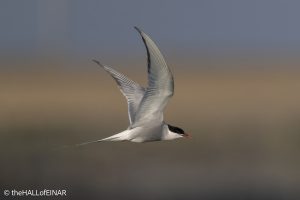The Arctic Tern and the Lumpfish
There are 60 Arctic Terns in this colony but sadly only three surviving chicks. That’s better than the collapsed colony at the other end of the Island did last year. There, we had no surviving chicks and the site was abandoned and hasn’t been reoccupied this year. It seems eerily empty without them and without the piratical Arctic Skuas which depended upon them.
The eager adult Terns are arriving with fish after fish and attempting to feed the few remaining chicks even though they aren’t their own. It’s called allofeeding and it’s a great way of using your surplus hunting capacity. It’s a bit much for so few chicks, though.
There are sand eels being brought in:

There are flatfish arriving:

But my favourite is when an adult arrives with a Lumpfish, especially one which is too big for such a small chick:

This poor chick tries for five minutes to swallow the Lumpfish, but each time only gets its head and shoulders down. It drops it several times and has to skitter into the sea in an attempt to retrieve it. I love the expression on both their faces.

Finally, it abandons it to the waves. Never mind. There’ll be another adult along in a minute with yet another meal. It won’t go hungry.
Lumpfish
In Scotland the Lumpfish, or Lumpsucker is known as the Cock-Paddle, while in Orkney it is locally referred to as the Padle. Reverend George Lowe wrote about it in his Fauna Orcadensis in 1813:
The Padle, as it is here called, is very frequent in our harbours, especially on the sand-banks, where I have seen half a dozen drawn ashore in a net at once, but never of any great bulk. It is an oddly-shaped creature; the back rises into a sort of hunch, on which is a part something resembling the comb of a cock; the side of the belly and sides have rows of hard tubercles, running along them towards the tail; the whole skin is rough, and the colour of those found in our harbour is black on the back, and greenish on the belly; whether they change colour as they increase in bulk, I know not.
The most curious part of this curious fish is a hollow under the pectoral fins, by which it adheres with great firmness to the stones, or any thing else where it can fix itself, so that when once it is fixed there is no removing it, and the stone may sooner be moved than it pulled away. This part, I imagine, acts much in the same manner as the circular piece of wet leather, which children use to run a string through the centre of, and clapping it on a stone, by the action of the air it is held with great force, so as to lift a very large stone, and sustain it as long as the leather continues moist, and the outward air is excluded by its closely embracing the solid body.
Now I really want to find a large adult washed up on Westray’s beaches.
More Arctic Terns
 Arctic Terns in the bay There's a small group of Arctic Terns in the bay. They are such beautiful birds. I love the long tail… read more
Arctic Terns in the bay There's a small group of Arctic Terns in the bay. They are such beautiful birds. I love the long tail… read more The beauty of Arctic Terns The Arctic Terns at the Bay of Tuquoy have had success with their breeding colony this year. It's been a… read more
The beauty of Arctic Terns The Arctic Terns at the Bay of Tuquoy have had success with their breeding colony this year. It's been a… read more A perfect hat-trick A perfect hat-trick in football is when you score three goals, one with your left foot, one with your right… read more
A perfect hat-trick A perfect hat-trick in football is when you score three goals, one with your left foot, one with your right… read more Not long out of the egg Arctic Terns are colonial nesting birds. I'm sure of that fact. I've spent 18 years exploring Westray and seeing their… read more
Not long out of the egg Arctic Terns are colonial nesting birds. I'm sure of that fact. I've spent 18 years exploring Westray and seeing their… read more An emotional state The Arctic Terns on Westray are bringing a succession of fish in to their youngsters. The beach is crowded with… read more
An emotional state The Arctic Terns on Westray are bringing a succession of fish in to their youngsters. The beach is crowded with… read more Beautiful conflict Aikerness is the most northerly part of Westray, where the wild waves crash and the wind blows uninterrupted by walls… read more
Beautiful conflict Aikerness is the most northerly part of Westray, where the wild waves crash and the wind blows uninterrupted by walls… read more Air to light Two years ago I took a photograph I love. It is of an Arctic Tern hovering, using a long exposure… read more
Air to light Two years ago I took a photograph I love. It is of an Arctic Tern hovering, using a long exposure… read more As cool as the Arctic The Arctic Terns on Westray are a curious bunch. If you start to care about them it can be an… read more
As cool as the Arctic The Arctic Terns on Westray are a curious bunch. If you start to care about them it can be an… read more Arctic Tern feeding A memory of last summer with the Arctic Terns of Westray. There were so few chicks in this colony that… read more
Arctic Tern feeding A memory of last summer with the Arctic Terns of Westray. There were so few chicks in this colony that… read more